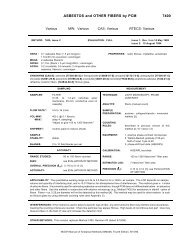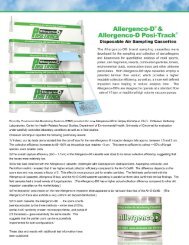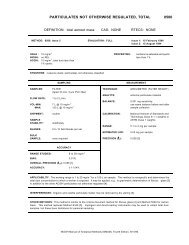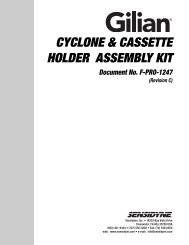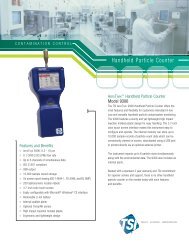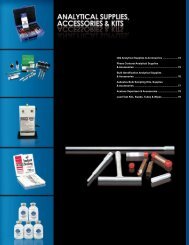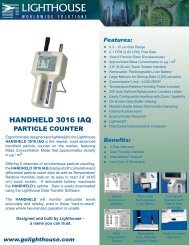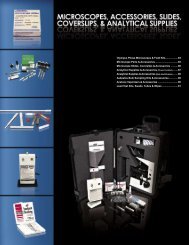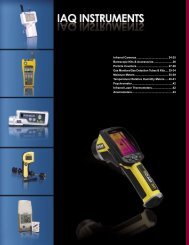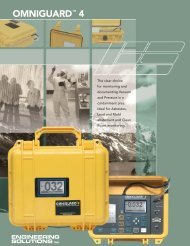CHROMIUM, HEXAVALENT 7604
CHROMIUM, HEXAVALENT 7604
CHROMIUM, HEXAVALENT 7604
You also want an ePaper? Increase the reach of your titles
YUMPU automatically turns print PDFs into web optimized ePapers that Google loves.
<strong>CHROMIUM</strong>, <strong>HEXAVALENT</strong>: METHOD <strong>7604</strong>, Issue 2, dated 15 August 1994 - Page 2 of 3REAGENTS:1. Sodium carbonate, anhydrous.2. Sodium hydroxide, reagent grade.3. Extraction solution, 2% NaOH/3% Na 2 CO 3 .Dissolve 20 g NaOH and 30 g Na 2 CO 3 indeionized water to make 1 L of solution.4. Eluent, 7.0 m M Na 2 CO 3 -0.5 mM NaOH.Dissolve 2.97 g Na 2 CO 3 in 4 L deionizedwater. Add 20 mL of 0.1 M NaOH (8g/L).5. Suppressor regenerant, 0.025 N H 2 SO 4 .Dilute 2.8 mL of conc. H 2 SO 4 in deionizedwater to 4 L.6. Cr(VI) standard, 1000 µg/mL.7. Calibration stock solution, 100 µg/mL. Dilute1000 µg/mL Cr(VI) standard 1:100 withdistilled or deionized water.8. Nitrogen, purified.9. Water, distilled or deionized.* See SPECIAL PRECAUTIONS.EQUIPMENT:1. Sampler: polyvinyl chloride (PVC) filter,5.0-µm pore size, 37-mm diameter (FWSB[MSA] or VM-1 [Gelman], or equivalent) withbackup pad in polystyrene cassette filterholder.NOTE: Some PVC filters promote reductionof Cr(VI). Check each lot of filters forrecovery of Cr(VI) standard.2. Personal sampling pump, 1 to 4 L/min, withflexible connecting tubing.3. Ion chromatograph, with conductivity detector,columns, suppressor (p. <strong>7604</strong>-1).4. Vials, scintillation 20-mL glass, PTFE-linedscrew cap.5. Forceps, plastic.6. Syringe, 10-mL, with in-line membrane filter0.45-µm pore size.7. Beakers, borosilicate, 50-mL.8. Watchglasses.9. Volumetric, flasks, 25-, 100-, and 1000-mL.10. Hotplate, 120 to 400 °C.11. Micropipette, 20-µL, and other sizes.12. Centrifuge tubes, 40-mL, graduated, withplastic, screw caps.SAMPLING:SPECIAL PRECAUTIONS: Insoluble chromatesare suspected human carcinogens [2]. All samplepreparation should be performed in a hood.1. Calibrate each personal sampling pumpwith a representative sampler in line.2. Sample at an accurately known flow rate in the range 1 to 4 L/min for a sample size of 100 to1000 L. Do not exceed 2 mg of particulate loading on the filter.3. Remove the filter from the cassette within 1 hour of completion of sampling, and place it in avial to be shipped to the laboratory. Handle the filters only with forceps. Discard the backuppad.SAMPLE PREPARATION:4. Place the filter face down in a 50-mL beaker, and add 5.0 mL extraction solution. Start reagentblanks at this point.NOTE 1: If significant amounts of Cr(III) are expected to be present, degas the extractionsolution by bubbling a slow stream of nitrogen through it for 5 min before proceedingand purge the headspace above the solution with nitrogen during this step.NOTE 2: If only soluble chromates are of interest use distilled water in place of extractionsolution.5. Cover the beaker with a watchglass and place on a hotplate preheated to 135 °C. Heat thesamples for 45 min with occasional swirling.NOTE 1: Do not allow the solution to boil or evaporate to dryness. Hexavalent chromium maybe lost by reaction with the PVC filter, as indicated by a brown coloring in the filter.NOTE 2: Longer heating times, up to 90 min. may be necessary for some samples (e.g., paintspray [1]).6. Cool the solution and transfer it quantitatively with distilled water rinses to a graduatedNIOSH Manual of Analytical Methods (NMAM), Fourth Edition, 8/15/94




